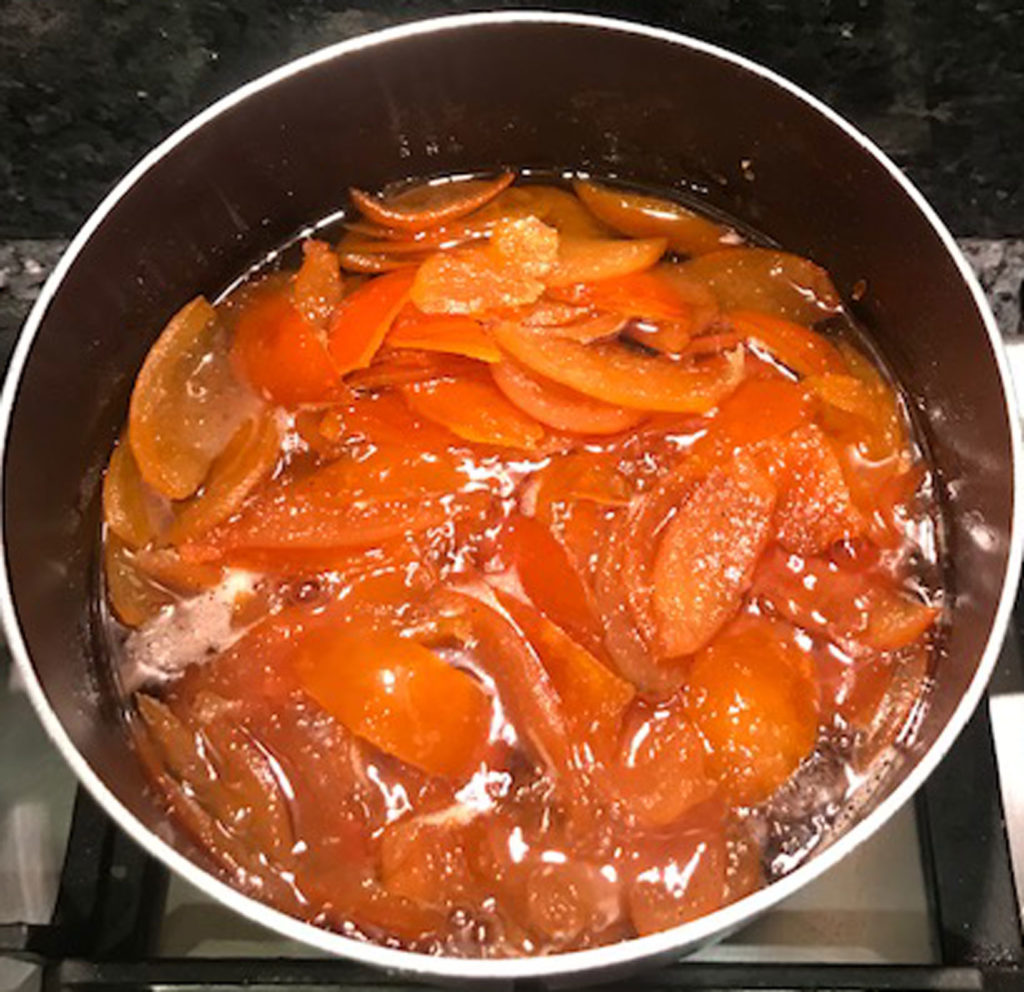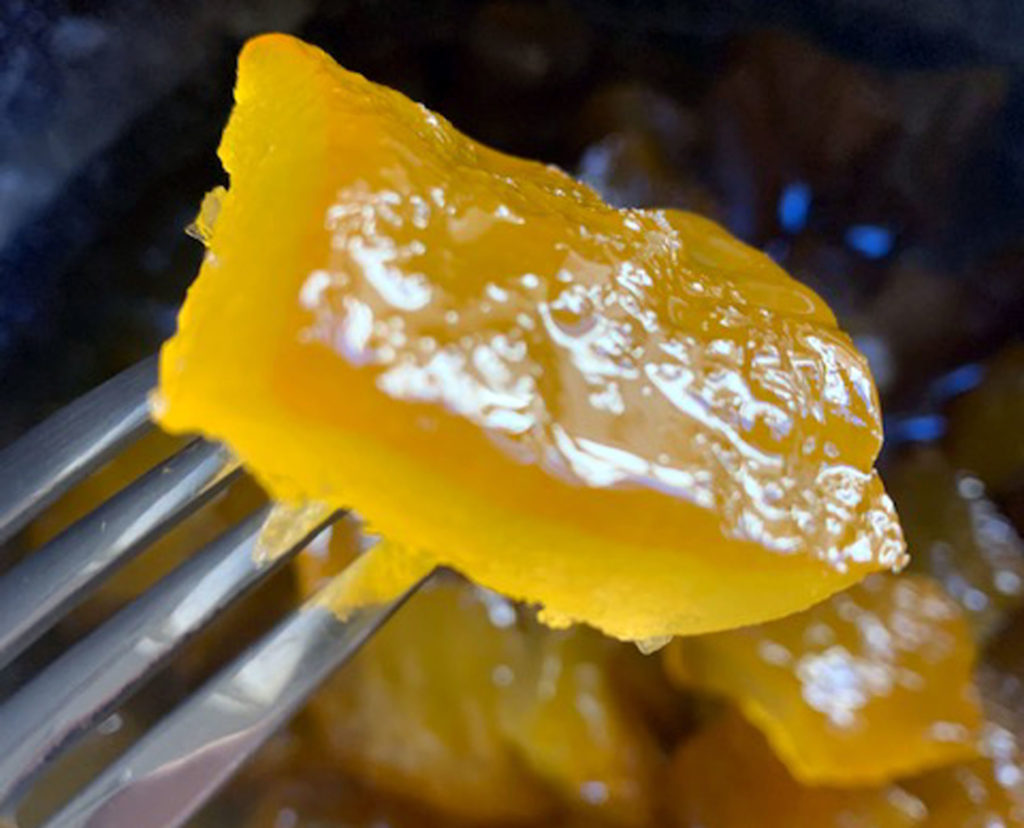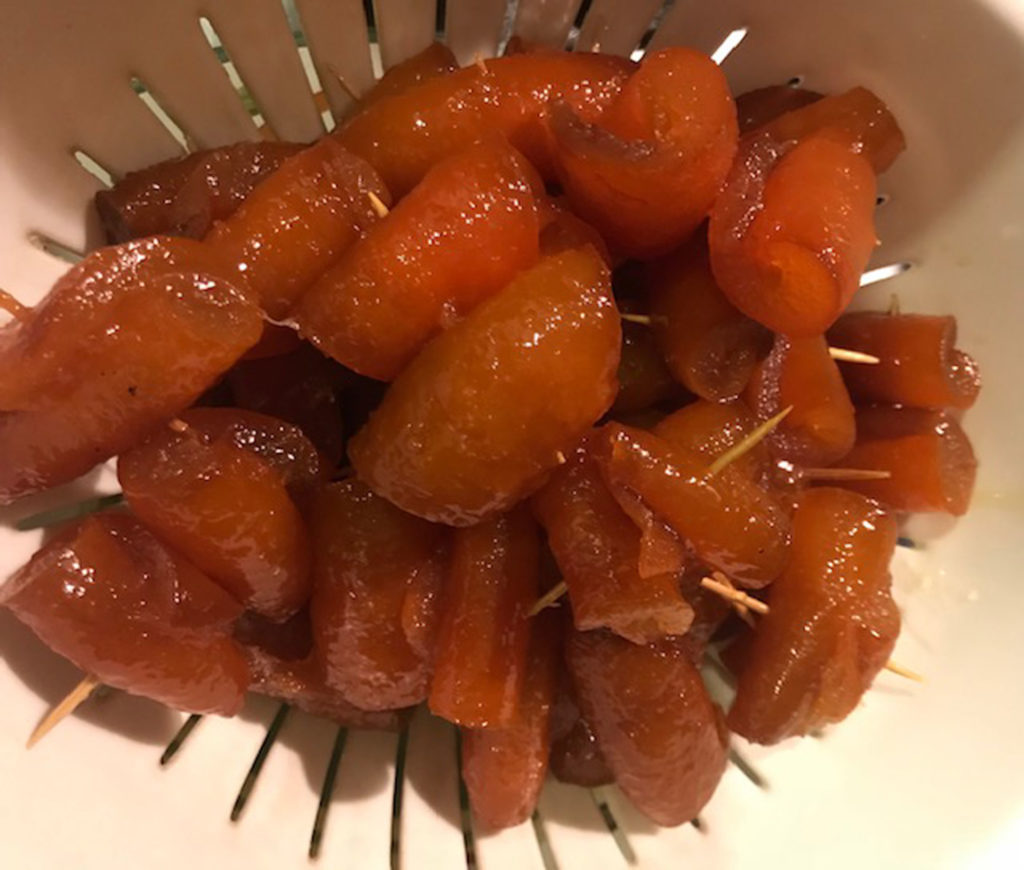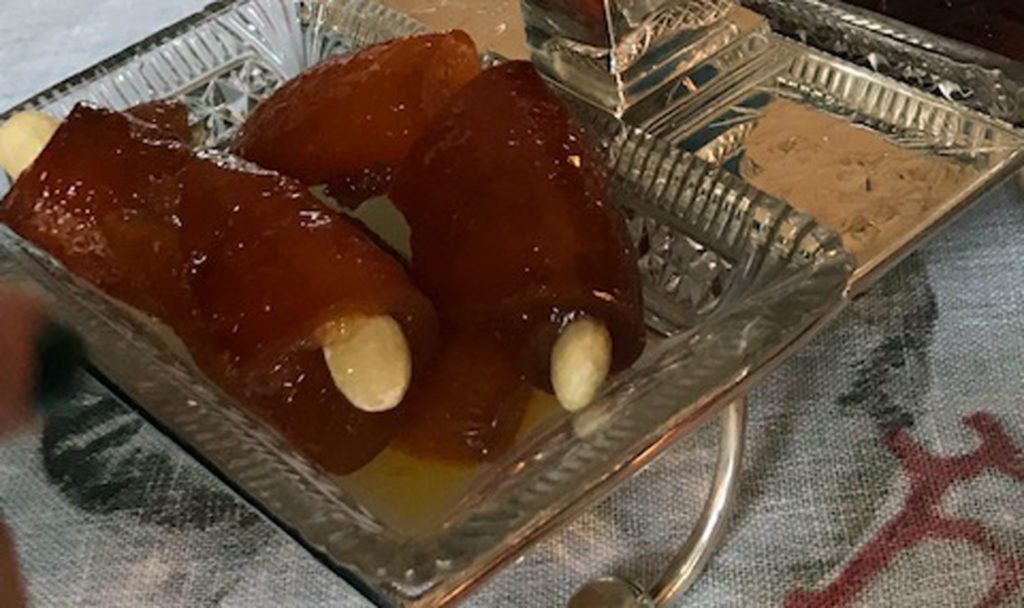Every winter, my kitchen smells like an orange grove for weeks on end. Or rather a candy factory. Or a mix of both. Because winter is the citrus season. For a Syrian, it is the season of candied orange and lemon peels, juicy and chunky pieces of translucent fruit skins that have gently simmered in sugar for several days until they reach perfection.
That perfection is the marriage of sweet and sour with a hint of bitter, a harmony that is very difficult to describe for the uninitiated. Winter is the season of naranj, these small bitter oranges that used to grow in most traditional houses in Damascus and Aleppo, Syria’s competing cities on everything culinary.
The word naranj is like the Spanish word for oranges, naranjas. I do not know which word came first, the Arabic or the Spanish one. When I encountered the houses in the south of Spain built around a courtyard full of citrus, I felt as if I were back home in Syria. These “Spanish” houses were built in Andalucia during the rule of the Umayyads from 711 to 1031 A.D. Damascus was the original capital of the Umayyads.
In Syrian courtyards, naranj trees are a fixture. While bitter oranges have acquired a reputation amongst the gastro-aficionados for their perfect fusion with dark chocolate, there are several citrus fruits that Syrians caramelize and then exchange as seasonal gifts. In Aleppo, in the north of Syria, the mother of all citruses is the huge, wrinkly “kabbad” — known in English as citron, or Citrus medica. Its scientific name gives away its vitamin overdose and medicinal qualities. Kabbad seems to be little known outside Syria, except in parts of Iraq and of Iran. Unlike naranj, known in Egypt as lareng, kabbad has not become a celebrated delicacy outside these three areas.


Syrians love to turn fruits into jams. To me, citrus fruits stand out. There is something magical about them. That combination of sweet and sour with a whiff of bitterness is unique. You must taste naranj or kabbad chunks glazed in syrup to get a sense of what I am trying to describe in words. No one glazes these fruits like Syrians do.
In Aleppo, kabbad has long been turned into these magical candied chunky pieces of fruits. One secret lost to the eons is that the Jews of Aleppo made the best glazed kabbad. Etrog, the Hebrew word for citron, is cited in the Old Testament and it is used by Jews during the religious harvest holiday of Sukkot. The fruit itself is depicted on various Hebrew antique artifacts and in archaeological sites. The Christians of Mosul in Iraq make citron jam (which they call torong) that they enjoy during the festivities around Easter. In Islamic civilizations, the Hebrew word etrog has been referenced for its medicinal value and a metaphor for something perfect in shape and content.
My father, a Muslim who grew up in a traditional Aleppo family, witnessed the annual ritual of making kabbad confiture. His nanny Rachel, an Aleppine Jew, kept her family’s centuries-old recipes close to her heart, sharing them only with people she loved. She did not share them with one of the matriarchs of my father’s family because, as my father recounts, the matriarch called Rachel only to ask for recipes. She never otherwise engaged with the nanny, which seems to have offended Rachel. In harmless revenge, she decided not to share the recipe for candied citron, the most generously succulent of all candied fruits.
It takes a lot of patience and a very methodical plan to perfectly candy and glaze the peels of a citrus fruit. Glazing a naranj means carving the fruit (keep the juice, it’s a fantastic replacement for lemon juice in salads), peeling and then cutting the skin lengthways into vertical strips, then soaking these strips in fresh water for a few days so they lose most of their bitterness. Careful: The peels should keep some remnants of bitterness, for that is what distinguishes them from regular oranges when they become a candy. It is precisely that bitter aftertaste that stays after the intense syrupy sensation one experiences when biting into a glazed naranj.
A few days into soaking the peels, it is time to candy them. In a large pot, where sugar syrup has been boiling, the orange peels or kabbad chunks are left to simmer. While kabbad pieces are squarish in form, bitter orange peel strips are rolled like a jelly roll. They are both removed from the long simmering process after the pieces become firmer thanks to thick syrup. It takes three days to concoct a perfectly candied bitter orange, that is to be able to see the deep hues of its skin titillate when you hold it up against the winter sun. And three days of simmering it must be. Three is almost a magical number.


These delicacies are preserved in air-tight glass jars in thick sugar syrup and can be offered throughout the year to guests and visitors. In the days before candies and chocolates were easily available, a refined snack offered to a visitor was glazed kabbad or naranj. Glazed means that the pieces of fruit peels are taken out of the jar, drained and dipped in sugar, served as candies next to a cup of cardamom-infused coffee. If one wanted to add a layer of welcome and luxury, then on would slip a shelled sliver of almond inside the rolled naranj before serving it to the guest.
In my kitchen in Amman, where I now live, I become my mother and my grandmother before her, all folded into one. I become the latest in a long line of female citrus jam makers that turn their kitchens into an orange grove and a candy factory. As I stand in front of my stove, I become the storyteller who knows that my father’s Jewish nanny opted not to share recipes with women of my family who did not give her due respect. Amid a lemony and sugary smell that sticks to the windows and walls, I become a toddler who munches on an orange peel while her mother or grandmother rushes around a kitchen in Damascus.
Every winter, I call on friends to give me part of their citrus harvests. Many do not make jams and indulge me with their fruits. Every winter, I carefully plan the whole thing, and post a trickle of updates on social media as the jams take form. In making naranj and kabbad glazes, I feel I own part of the Syria story that might otherwise have been lost: a Syria of abundance, gastronomy, delicatessens, beauty and generosity.
Over the past decade in which Syria has been torn apart, I have clung to cooking to stay attached to a country that is no longer the one I had long known, the one that had been mine, my home. I have spent hours in the kitchen resuscitating old recipes, calling my mother and relatives in other countries to confirm or rectify my recollection of a dish. I am part of several groups on social media that exchange Levantine recipes, and I am a witness to arguments that can sometimes amount to a virtual civil war among Syrians from different regions over the best spices to be used in a certain dish or the optimal method of making a specific meal.
Despite the growing divisions, real and manufactured, Syrians are still able to engage around food. Facebook abounds with discussions about regional dishes that sometimes take a sectarian undertone, which is largely tolerated. Sectarianism in food discussions often becomes an endearing quality.
The Armenian community from Aleppo, today mostly residing outside Syria, prides itself for some of the most sophisticated combinations of sweet and sour, like their famous cherry kebabs. The Druze, a mystical community from the central Sweida region swear by their mansaf, a celebratory meat and burghul (cracked wheat) mix with a yogurt-based stew that the Sunni tribes of Horan in southern Syria also cook, like their relatives across the border in Jordan.
Damascenes master the art of fatteh, a layered dish of crispy pita bread, yogurt and a variety of ingredients that are topped with pine nuts and almonds. Homs, in the center of Syria and once the epicenter of the Syrian uprising in 2011, is the country’s homeland of eggplants. The aubergines that make the best makdous — small eggplants stuffed with walnuts and pepper paste, pickled and then submerged in olive oil, come from Homs. The Syrian Valley of the Christians, Wadi al Nasara, offers the most colorful tables of mezze, the Levantine tapas that are so varied in flavors that there is often no need for a main course after them. Christian towns and villages often boast sprawling views of the mountains that they are nestled between, where one can spend hours nibbling on these small plates, washing their content down with robust arak made in the local monasteries.
Can one convey a smell? Marcel Proust successfully described how he would plunge back into childhood when he dipped his madeleine in tea. I plunge back into a childhood with a whiff of lemon, thrown into the visual and olfactory memories of jam-making in my grandmother’s kitchen in Damascus. I spent a lot of time with my grandmother and can still subsist on what I remember of many winters and summers in a kitchen overlooking a courtyard with naranj and kabbad trees.
My grandmother, and probably every other grandmother in Damascus and Aleppo at the time, treated jam making like witchcraft — the good kind. In a large pot on the oven, the concoction simmered, emitting a discreet clickety sound and an intense lemony smell.
There are many ways to tell the Syrian story of the past 11 years, most of them painful. Aspirations crushed, a country decimated, a population that struggles today to cover its most basic needs. In that context, jam-making is a luxury. But one way of keeping parts of the Syrian story alive is to relentlessly cling to stories, flavors and smells that help me, and probably Syrians like me, reconstitute a country that can be a peaceful and pleasurable place, even if only in our minds.
I move the pots around, gently churning their content. I look at the pieces of fruits to assess their graduation from raw to candied chunks of absolute beauty. Making jams from two very Syrian citrus fruits brings me immense joy and melancholy. “This night is gold,” I recite to myself, quoting Palestinian poet Mahmoud Darwish, as I move with a chunk of kabbad towards the window. My father told me that a perfectly candied citron should be golden and translucent, with the light cutting through it. I have in my hand a perfectly candied piece of kabbad, pure gold. If Saint Paul saw the light on his way to Damascus, I now see the light of Damascus in my kitchen. If I could put my Syria in a pot, it would be a pot of naranj and kabbad jam that shines against the morning light.



